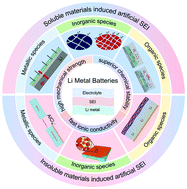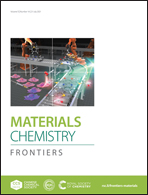Materials chemistry among the artificial solid electrolyte interphases of metallic lithium anodes
Abstract
Lithium (Li) metal is regarded as one of the most promising anode materials owing to its high theoretical capacity of 3860 mA h g−1 and the lowest reduction potential of −3.04 V. However, the practical application of Li anode still faces serious hindrances due to uncontrolled dendrite growth, the unstable interface and the infinite volume changes during the Li plating/stripping process, ultimately causing serious safety concerns and fast capacity fading. To overcome these challenges, the solid electrolyte interphase (SEI) nanostructures originating from the in situ electrolyte reduction by metallic Li have been widely recognized to be undoubtedly crucial. Recently, numerous strategies have been developed to construct artificial SEI with high mechanical strength, superior chemical stability and fast ionic conductivity. In this contribution, based on the discussions on the intrinsic mechanisms of formation and invalidation of SEI nanostructures, we summarize the progress of artificial SEI establishment in the order of the distinguished chemical composition and aggregative state of the precursor materials: soluble or insoluble metallic, inorganic and organic species. Particularly, outlooks on the future advances in artificial SEI investigations from the perspective of the comprehensive and dynamic nanostructured chemistry identifications are proposed, which are believed to offer basic principles towards the design of safe and long-lived Li metal batteries.

- This article is part of the themed collections: Energy storage with rechargeable Li batteries and beyond and 2021 Materials Chemistry Frontiers Review-type Articles


 Please wait while we load your content...
Please wait while we load your content...